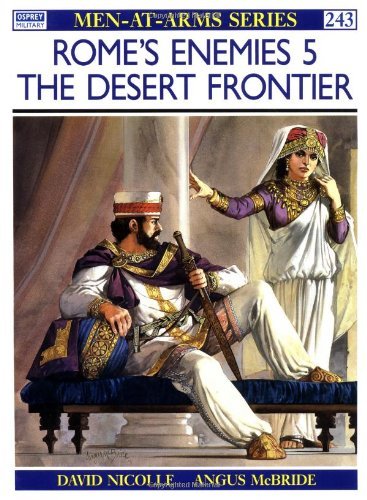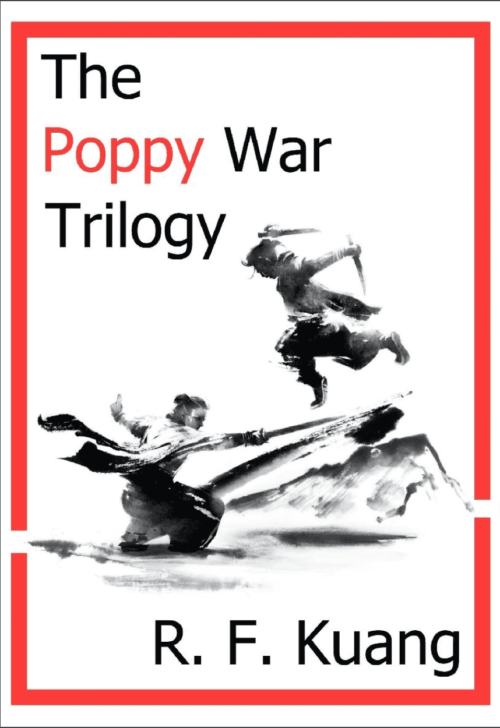“Rome’s Enemies (5): The Desert Frontier” by David Nicolle & Angus McBride
Sands of Resistance: Rome’s Forgotten Wars on the Arid Margins
Overview
Authored by historian David Nicolle and illustrated by military artist Angus McBride, this volume from Osprey’s Men-at-Arms series (No. 243) explores Rome’s complex interactions with desert peoples along its Saharan and Arabian frontiers. Combining archaeological evidence, Roman accounts, and McBride’s vivid reconstructions, the book dismantles the myth of desert tribes as mere “nomadic raiders,” revealing their adaptive warfare, cultural hybridity, and strategic resilience. Rated 4.0/5.0, it serves as a visual and scholarly guide to the forgotten conflicts that shaped Rome’s southern frontiers.
Key Features
- Desert Warfare Dynamics
- Hit-and-Run Tactics: Arab and Berber tribes exploited mobility and terrain, ambushing legions with sudden strikes before vanishing into the desert. Their camel cavalry (A3 figure) and light javelin throwers (D1) outmaneuvered Rome’s heavy infantry.
- Psychological Warfare: Tribes like the Garamantes (A3) used litham face veils and ritual drumming to unnerve enemies, while Nabatean camel archers (D1) blended stealth with psychological intimidation.
- Cultural Synthesis & Military Innovation
- Numidian Nobility: A1 illustrates a 2nd-century BCE Numidian prince with a Carthaginian helmet, imported chainmail, and a locally forged sword. His hybrid gear reflects trade networks linking Greece, Carthage, and Saharan metallurgy.
- Meroitic Sudan: B1-B3 plates depict Meroe warriors wielding Egyptian-style longbows and Greek-influenced swords, while noblewomen (B3) wore gold vulture crowns symbolizing divine authority.
- Roman Adaptation & Legacy
- Border Militias: By the 4th century CE, Rome relied on Nubian auxiliaries (C3) and hybrid units like the Limitanei to patrol deserts. These troops adopted local tactics, such as using poisoned arrows (C2).
- Trade vs. Conflict: While the frontier saw mutual trade (e.g., Saharan salt for Roman glass), clashes erupted over caravan routes. The Limes Tripolitanus fortifications exemplify Rome’s struggle to control oases like Ghadames.
Translation with Contextual Additions
(Original Text Translated and Enhanced for Global Audiences)
Title: Rome’s Enemies (5): The Desert Frontier
Authors: David Nicolle (text), Angus McBride (illustrations)
Format: Paperback
Rating: 4.0/5.0 (0 reviews)
Full Description:
Nicolle’s analysis redefines desert tribes as masters of asymmetric warfare, blending steppe mobility with intimate knowledge of arid ecosystems. The book highlights pivotal moments like the Garamantian raids (1st century BCE) and Nabatean caravan wars, while McBride’s 8 full-page plates—based on artifacts like the Star-Spangled Helmet from Al Sumaa and Meroe Temple carvings—revive figures such as a 4th-century Blemmye archer (C2) with silver wrist guards and a Romanized Nubian king (C1) in chainmail
Key Enhancements for Clarity:
- Geopolitical Context: Explains how Rome’s desert frontier stretched from Syria to Mauretania, with tribes like the Berbers and Nabateans acting as both trading partners and raiders.
- Ethical Debates: Challenges Roman narratives of “barbarian savagery” by highlighting tribal legal systems (e.g., Meroe’s matrilineal succession) and urban planning (e.g., Garamantian foggaras irrigation).
- Legacy: Traces desert warfare’s influence on later Islamic armies and medieval Saharan states like Kanem-Bornu.
Why Western Readers Should Care:
- Complements Osprey’s Rome’s Enemies series but emphasizes non-European perspectives, bridging Barry Cunliffe’s The Ancient Celts and James Barr’s Desert Kings.
- Reveals how climate and ecology shaped ancient empires—a theme resonant in modern debates over resource conflicts.
Visual & Academic Enhancements
- McBride’s Artistry: Plates include a Nabatean camel rider (D1) with bamboo bows and a Roman Limitanei soldier (C3) in hybrid gear, based on Petra pottery and Luxor Temple murals.
- Archaeological Fidelity: Drawings reference the Kalabasha Temple reliefs (C1) and Ballana tomb weapons (C2), ensuring historical accuracy.







评价
目前还没有评价